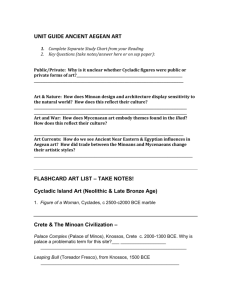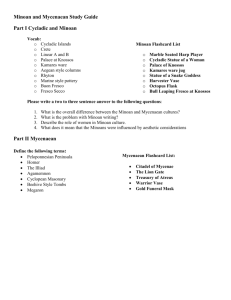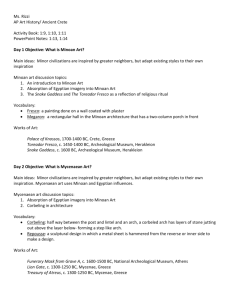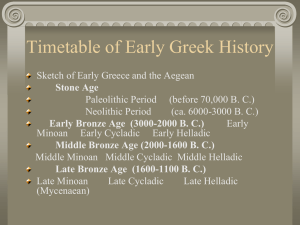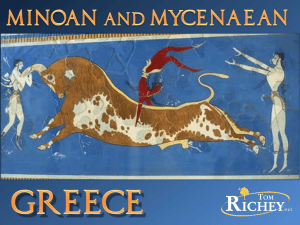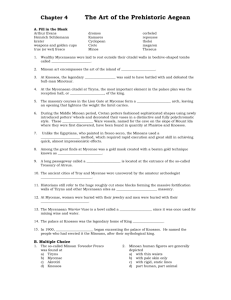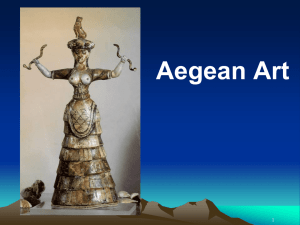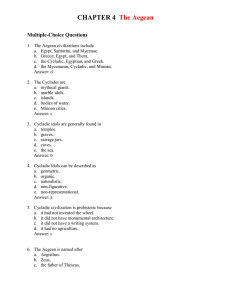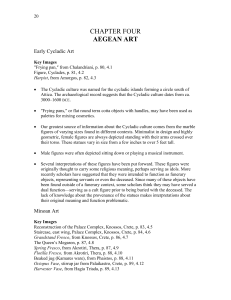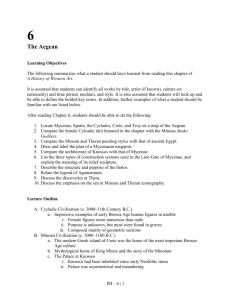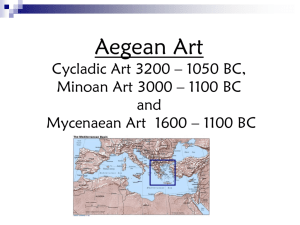Chapter 04 Test Bank
advertisement
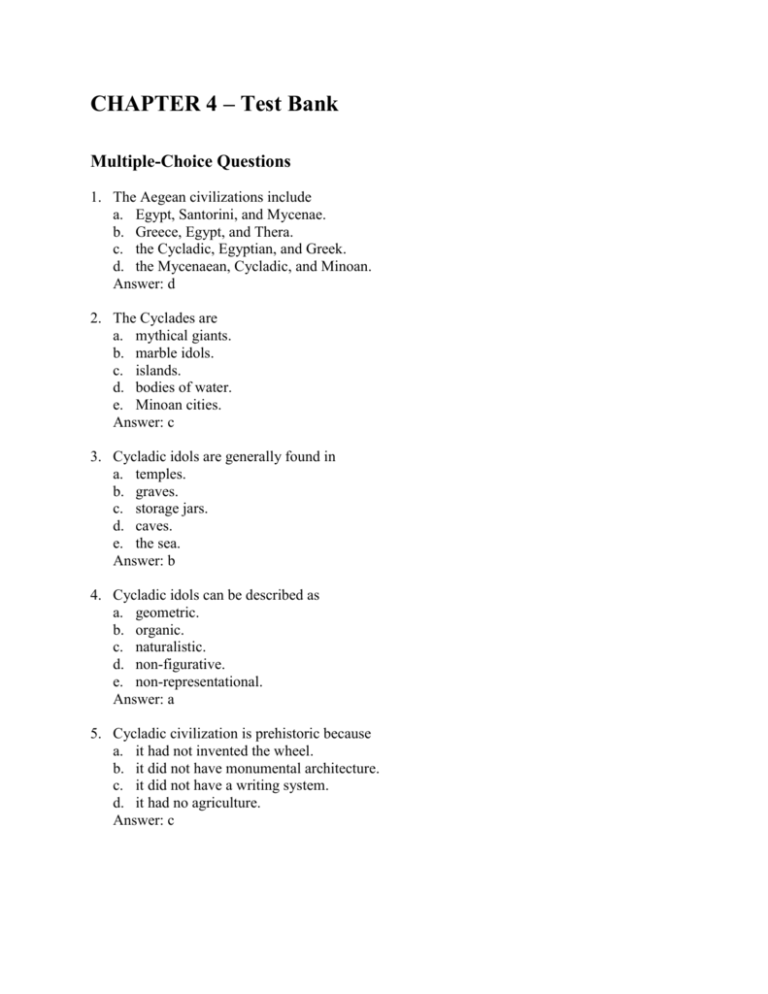
CHAPTER 4 – Test Bank Multiple-Choice Questions 1. The Aegean civilizations include a. Egypt, Santorini, and Mycenae. b. Greece, Egypt, and Thera. c. the Cycladic, Egyptian, and Greek. d. the Mycenaean, Cycladic, and Minoan. Answer: d 2. The Cyclades are a. mythical giants. b. marble idols. c. islands. d. bodies of water. e. Minoan cities. Answer: c 3. Cycladic idols are generally found in a. temples. b. graves. c. storage jars. d. caves. e. the sea. Answer: b 4. Cycladic idols can be described as a. geometric. b. organic. c. naturalistic. d. non-figurative. e. non-representational. Answer: a 5. Cycladic civilization is prehistoric because a. it had not invented the wheel. b. it did not have monumental architecture. c. it did not have a writing system. d. it had no agriculture. Answer: c 6. The Aegean is named after a. Aegisthus. b. Zeus. c. the father of Theseus. d. the Minotaur. e. the daughter of Minos. Answer: c 7. Minoan Civilization is generally dated a. 4000 to 1000 B.C. b. 3000 to 1500 B.C. c. 3500 to 1000 B.C. d. 2500 to 1500 B.C. e. 4500 to 2000 B.C. Answer: b 8. The Minotaur was a. the king of Crete. b. half bull, half man. c. the son of Icarus and Daedalus. d. a hero of many happy legends. Answer: b 9. Minos was the son of a. the Minotaur and Europa. b. Zeus and Ariadne. c. Theseus and Ariadne. d. Europa and Theseus. e. Zeus and Europa. Answer: e 10. The Minoan civilization was discovered by a. Schliemann. b. Evans. c. Marinatos. d. Plato. e. Theseus. Answer: b 11. The Palace at Knossos was not fortified because a. the inhabitants of Crete were peace-loving. b. the Minoans thought of themselves as invincible. c. Crete is an island. d. Crete ruled the Aegean. Answer: c 12. Minoan frescoes were a. fresco secco. b. more stylized than in Egypt. c. more abstract than in Egypt. d. more numerous than in Egypt. e. true fresco. Answer: e 13. As far as one can tell, the most sacred animal on Minoan Crete was a. the lion. b. the bull. c. the griffin. d. the snake. e. the duck. Answer: b 14. Which is true of Minoan scripts? a. Linear A was used for lists and Linear B was the written script. b. Linear A and Linear B were written scripts. c. Linear B and Linear A were Egyptian scripts. d. Linear B was used for records and Linear A was the written language. e. Linear A was used on papyrus and Linear B was inscribed on tablets. Answer: d 15. The statue of the so-called Snake Goddess is made of a. terracotta. b. fresco. c. marble. d. faïence. e. Kamares. Answer: d 16. The Minoan column has a. a lotus capital, a straight shaft, and a square base. b. a floral capital, a tapering shaft, and a pillow base. c. a pillow capital, a round base, and a tapering shaft. d. a papyrus capital, a round base, and a tapering shaft. e. a bull capital, a round base, and a tapering shaft. Answer: c 17. Kamares ware can be characterized as a. monochrome. b. decorated with dynamic designs. c. organic. d. figurative. e. decorated with Linear B script. Answer: b 18. Which is NOT a Minoan site? a. Mycenae b. Phaistos c. Palaikastro d. Knossos Answer: a 19. The modern name for Thera is a. Knossos. b. Cairo. c. Anatolia. d. Santorini. e. Atlantis. Answer: d 20. Which is NOT a Theran fresco? a. the Ship Fresco. b. the Boxing Children. c. the Toreador Fresco. d. the Crocus Gatherer. Answer: c 21. Thera seems to have been destroyed by a volcanic eruption in a. 1628 B.C. b. 1400 B.C. c. 1250 B.C. d. 1500 B.C. Answer: a 22. The most likely interpretation of the Boxing Children is as a. a Cycladic sport. b. a personal dispute. c. a theatrical performance. d. an initiation ritual. e. a religious ritual. Answer: d 23. A pinched waist, profile pose, and “floating” forms are typical of the frescoes of a. Assyria. b. Crete. c. Egypt. d. Rome. Answer: b 24. The general dates for the Mycenaean civilization are a. 1800 to 1600 B.C. b. 1600 to 1400 B.C. c. 1400 to 1200 B.C. d. 1800 to 1400 B.C. e. 1600 to 1200 B.C. Answer: e 25. Schliemann found a. Knossos. b. Mycenae. c. Troy. d. both Mycenae and Troy. Answer: a 26. The term Helladic comes from a. Helen of Troy. b. the Greek name for Greece. c. the Greek name for Helen. d. the islands of the Hellades. e. the Greek name for Troy. Answer: b 27. Mycenaean shrines were a. on hillsides. b. in temples. c. in palaces. d. at the edge of the sea. e. on hilltops. Answer: c 28. Agamemnon and Klytemnestra were the parents of a. Elektra, Orestes, and Kassandra. b. Iphigenia, Kassandra, and Orestes. c. Elektra, Iphigenia, and Kassandra. d. Elektra, Orestes, and Iphigenia. Answer: d 29. Mycenaean civilization was discovered by a. Evans. b. Schliemann. c. Marinatos. d. Aeschylos. e. Euripides. Answer: b 30. The heroes of Homer’s Iliad and Odyssey may have come from a. Minoan Crete. b. Athens. c. Mycenaean Greece. d. Santorini. Answer: c 31. Which of the following was NOT a Trojan? a. Priam. b. Paris. c. Menelaus. d. Kassandra. Answer: c 32. A corbeled vault is a. concentric stone rings piled to make an arch or domed room. b. a means of transporting water. c. a kind of tomb. d. the level of windows above the central passageway to let light in from outside. Answer: a 33. Cyclopaean refers to a. a group of islands. b. a kind of wall. c. a citadel. d. a style of painting. e. a grave circle. Answer: b 34. Polyphemos was a. a Greek artist. b. a Greek city. c. a Greek hero. d. a Cyclops. e. a friend of Odysseus. Answer: d 35. Minoan features suggest that although found in Mycenae, the ________ is/are Minoan. a. the Vapheio Cups. b. the Harvester Vase. c. the Octopus Vase. d. the Agamemnon Mask. Answer: a 36. The column flanked by lions at the entrance to the citadel at Mycenae symbolized a. a phallus. b. a tree. c. a goddess. d. a building. e. an altar. Answer: c 37. Niello is a. a ceremonial dagger. b. an alloy that contains sulfur and silver. c. a decorative inlay. d. an alloy of copper and tin also known as bronze. e. the original name for Crete. Answer: b
